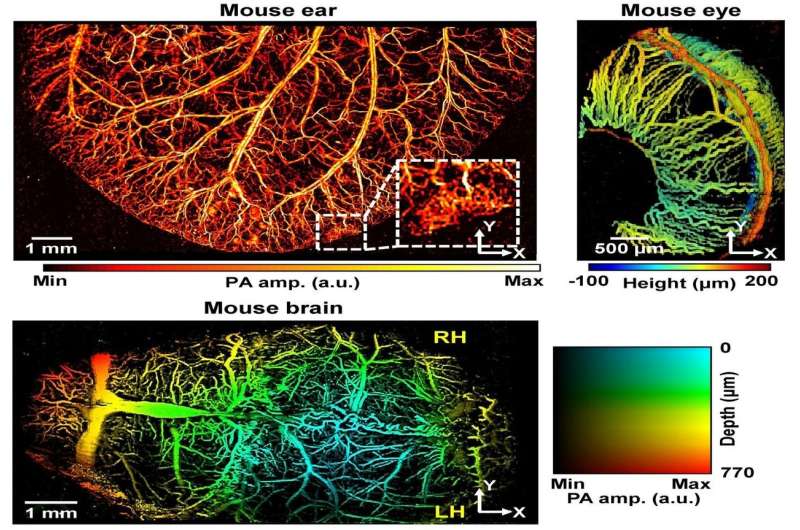Photoacoustic images of microvessels in the ears, eyes, and brains of mice captured by the newly developed photoacoustic microscopy Credit: Chulhong Kim (POSTECH)
200 years ago, a doctor from France used a stethoscope for the first time. Countless efforts to observe the human body have been made since then. Up to now, the best tool that provides anatomical, functional, and molecular information about humans and animals is the photoacoustic microscope. Super-resolution localization photoacoustic microscopy, which is 500 times faster than conventional photoacoustic microscopy, has been developed by a research team from POSTECH in Korea.
Professor Chulhong Kim of Creative IT Engineering from POSTECH with Jinyoung Kim, a research professor, and Jongbeom Kim, a Ph.D. student, presented a fast photoacoustic microscopy system with a custom-made scanning mirror in the international journal published by Nature, Light: Science and Applications. This newly developed microscopy technique uses a stable and commercial galvanometer scanner with a custom-made scanning mirror and can find blocked or burst blood vessels by monitoring the flow of red blood cells without using a contrast absorber.
Photoacoustic microscopy images cells, blood vessels, and tissues by inducing vibrations when the optic energy is converted to heat after an object absorbs light from laser beam. Conventional photoacoustic microscopy systems using a galvanometer scanner have a narrow field of view because they do not scan photoacoustic waves but only the optical beam. These systems using a linear motorized stage also have a temporal limitation in making images.
The research team developed a new photoacoustic microscopy system with improved performance. It can scan both photoacoustic waves and optical beams simultaneously, as the researchers implemented a custom-made scanning mirror within an existing photoacoustic microscopy system. It can also monitor very small vessels using intrinsic red blood cells without a contrast absorber, which is a major performance enhancement. Furthermore, the new system is 500 times faster than conventional systems. With the improvement, it can demonstrate super-resolution imaging by localizing photoacoustic signals with spatial resolution enhanced 2.5 times.
Their research accomplishment is meaningful in many ways. This system is expected to be very promising in diagnosis and treatment of stroke and cardiovascular disease. Because it can monitor and image blood vessels with the flow of blood cells in real time, it can also be used for vascular disease that requires urgent diagnosis and treatment. Moreover, it allows direct monitoring of hemodynamics in the microvessels. It is anticipated to be applied in various fields including hemodynamic response, contrast agent dynamics in blood vessels, and transient microcirculatory abnormalities.
Professor Chulhong Kim said, "We successfully imaged microvessels in the ears, eyes, and brains of mice, and a human fingertip with this new photoacoustic microscopy system. What we have developed can be a complimentary tool to the conventional brain imaging system and it can also be a promising tool for future preclinical and clinical studies."
More information: Jongbeom Kim et al, Super-resolution localization photoacoustic microscopy using intrinsic red blood cells as contrast absorbers, Light: Science & Applications (2019). DOI: 10.1038/s41377-019-0220-4
Journal information: Light: Science & Applications
Provided by Pohang University of Science & Technology
























